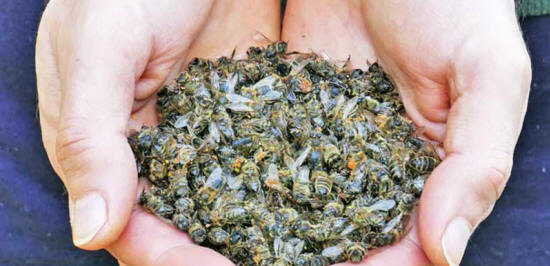|
by Justin Gardner
from
TheFreeThoughtProject Website man would have no more than four years to live." Albert Einstein
(allegedly)
On September 22 we reported that the rusty-patched bumblebee was proposed by the U.S. Fish and Wildlife Service to be listed as an endangered species.
This is a wake-up call to the problem of habitat destruction and pesticide use - particularly neonicotinoid pesticides - as this native bee is the first in the continental U.S. to be formally proposed for endangered species listing.
However, as bees are concerned, that was just the tip of the iceberg.
While the plight of the bumblebee is finally getting the attention it deserves, other native bees are on a fast track to extinction and have already been declared endangered.
On September 30, for the first time ever, bees were put on the Endangered Species list.
Seven species of Hawaiian yellow-faced bee in the genus Hylaeus, once the most abundant insects on the tropical islands, are now so scarce that they one of the state's least observed pollinators.
The Xerces Society, a nonprofit group dedicated to protecting invertebrates and their habitats, submitted a petition in 2010 to protect the seven yellow-faced bee species, so named for a golden mark on between the males' eyes.
These tiny, beautiful creatures are critically important to the pollination of native flowering plants and the unique island ecosystems of Hawaii.
Over millions of years, the bees and certain flowers have evolved specialized plant-pollinator interactions where both organisms derive benefits. If the bees disappear, certain flowering plants can disappear too and this has a domino effect in the ecosystem.
The yellow-faced bees have also evolved curious nesting behaviors.
But island inhabitants are especially susceptible to invasive species, such as rival Hylaeus bees from India, and ants - which were previously unknown to Hawaii.
The ants make an easy meal of yellow-faced bee nests, which have evolved no protections from these voracious opportunists.
The endangered species listing is sure to accelerate efforts to protect the native bees, such as artificial nest boxes that keep ants out and placing them in areas where bees no longer live so they can reestablish populations.
Conserving the remaining natural habitat is also crucial in protecting the bees and other dwindling native plant and animal species.
On the larger issue of protecting bumblebee and other native bee populations from going extinct, it is time for agribusiness and government to admit that neonicotinoid pesticides (neonics) - which have become the favorite poison of the chemically-dependent, industrial agriculture system - are devastating bees and other beneficial organisms.
For too long, the corporate purveyors of these toxic chemicals, such as Bayer and Monsanto, along with their partners in federal agencies, have been hiding and downplaying the science on neonics.
While numerous formulations have been rubber-stamped for approval, securing billions in profits and kickbacks, environmental and human health have been the victims.
Not only is this driving many species to extinction, but it also poses a grave threat to our agricultural integrity, as bumblebees and honey bees play a critical role in pollinating fruit crops.
The bumblebees' contribution to farms is estimated at $3.5 billion.
It's time for habitat loss and pesticide use to become front page news, before we wake up to find these beneficial creatures gone forever, and with it, the stability of our food system and natural ecosystems...
Saving Bumblebees Became this
Photographer's Mission is on a quest to tell the stories of American native bees, and one elusive species - the rusty-patched bumblebee - has become his "white whale."
|


